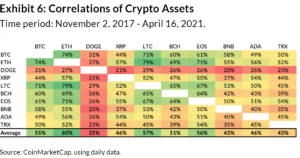Simple Ways to Order Cryptocurrencies: Beginner-Friendly Operating Systems Explained
The Future of Cryptocurrencies: Fads to Enjoy in the Upcoming Years
The introduction of Central Financial institution Digital Currencies (CBDCs) stands to redefine the integration of electronic assets within typical economic systems, while raised governing examination may shape the operational landscape for cryptocurrencies. Furthermore, the development of decentralized money (DeFi) and the growing relevance of non-fungible symbols (NFTs) guarantee to modify assumptions of possession and valuation in an electronic economic situation.
Rise of Reserve Bank Digital Currencies
The introduction of Reserve bank Digital Currencies (CBDCs) represents a substantial change in the monetary landscape as federal governments check out digital options to standard fiat money. These state-backed electronic currencies aim to improve the efficiency of repayment systems, advertise economic incorporation, and give a secure alternative to private cryptocurrencies. Unlike decentralized electronic money, CBDCs operate under the auspices of reserve banks, making certain governing oversight and security.
A number of nations are proactively piloting or looking into CBDCs, with notable instances consisting of China's digital yuan and the European Reserve bank's electronic euro campaign. These efforts highlight an expanding recognition of the potential benefits of electronic currencies, such as faster transaction speeds and minimized expenses related to cross-border settlements. Moreover, CBDCs could work as a tool to deal with illicit activities by providing higher openness in purchases.
As the fostering of CBDCs proceeds, they might reshape customer behavior and impact international monetary dynamics. The shift to a digital money structure provides obstacles, including technical framework, cybersecurity worries, and public count on. The surge of CBDCs signifies a pivotal minute that can redefine the role of money in an increasingly digital economy, necessitating close observation by industry stakeholders and policymakers alike.
Enhanced Regulative Analysis

Countries around the world are taking different methods, from outright restrictions to regulatory sandboxes that permit innovation while guaranteeing compliance. The European Union, for instance, is moving in the direction of extensive regulations with the Markets in copyright-Assets Law (MiCA), focused on developing a unified strategy throughout participant states. In the United States, agencies like the SEC and CFTC are progressively energetic in issuing guidelines and enforcement activities.
Business operating in the copyright area might encounter more stringent conformity needs, which can lead to raised functional costs. Ultimately, the balance between advancement and policy will shape the future of cryptocurrencies.
Evolution of DeFi Operatings Systems
Decentralized Finance (DeFi) systems have actually undertaken significant improvement since their creation, improving the standard economic landscape - order cryptocurrencies. Initially, these systems mainly concentrated on straightforward functions such as financing and borrowing, facilitated by smart contracts on blockchain networks. Nonetheless, the evolution of DeFi has increased to incorporate a large array of economic services, consisting of by-products trading, return farming, and automated market-making.
One of one of the most remarkable advancements is the emergence of Layer 2 remedies, which improve scalability and decrease purchase costs, making DeFi extra accessible to a more comprehensive target market. Additionally, cross-chain interoperability has actually become an important focus, permitting users to transfer assets effortlessly across various blockchain networks. This evolution cultivates higher liquidity and user engagement.
Additionally, the combination of advanced administration models has actually empowered areas to join decision-making procedures, advertising sustainability and development within the ecosystem. As DeFi proceeds to grow, we can expect further improvements in user experience via enhanced user interfaces and protection procedures, resolving issues that have actually previously impeded mainstream fostering. In general, the trajectory of DeFi platforms factors useful content toward a much more inclusive and efficient economic future, providing alternatives to standard banking systems.
Integration of NFTs in Financing
Amidst the quick development of the financial landscape, the assimilation of Non-Fungible Tokens (NFTs) has become a transformative pressure. Traditionally connected with electronic art and antiques, NFTs are currently finding applications in different economic sectors, presenting cutting-edge methods to stand for ownership and worth.
One significant area of assimilation is in real estate, where NFTs can improve home purchases. By tokenizing property properties, buyers can delight in fractional ownership, decreasing entry obstacles and boosting liquidity. order cryptocurrencies. Furthermore, NFTs can guarantee clear and unalterable records of possession, enhancing trust in real estate transactions
In the world of finance, NFTs are additionally being made use of for decentralized finance (DeFi) applications, allowing collateralization of possessions. By using NFTs as collateral, debtors can access finances while maintaining possession of their electronic assets. This performance boosts the ease of access of financial solutions and promotes a much more inclusive monetary environment.
In addition, the integration of NFTs right into typical financing can transform the way intellectual building rights are handled, giving designers see here with new profits streams via wise agreements. Overall, the combination of NFTs in financing symbolizes a shift in the direction of even more cutting-edge, effective, and transparent economic remedies, leading the way for future advancements.
Innovations in Blockchain Technology

One significant fad is the emergence of Layer 2 remedies, created to boost scalability and deal speeds, thus addressing the restrictions of primary blockchain networks. These remedies make it possible for quicker processing of deals, decreasing charges and boosting effectiveness, which is crucial for mass adoption.
Additionally, interoperability in between various blockchain networks is obtaining traction. This advancement permits smooth information exchange and possession transfers across varied platforms, advertising a more connected and effective ecological community. Protocols that promote cross-chain communication are necessary for cultivating collaboration among decentralized applications (copyright) and boosting individual experiences.
Furthermore, developments in agreement systems, such as proof-of-stake and delegated proof-of-stake, are adding to even more energy-efficient and protected blockchain procedures. These page developments not only attend to ecological concerns however also boost network strength.
As blockchain technology continues to grow, its assimilation into different industries, including financing, supply chain, and health care, will redefine typical systems, leading the way for a decentralized future.
Final Thought
Finally, the future of cryptocurrencies is defined by transformative patterns that will certainly shape the financial landscape. The emergence of Central Financial institution Digital Currencies will enhance the assimilation of digital properties into conventional monetary systems. Concurrently, regulative frameworks will evolve, advertising institutional investment while ensuring customer security. Additionally, the continuous advancement of decentralized finance platforms and blockchain modern technology, together with the assimilation of non-fungible tokens, will redefine possession and financial deals, fostering boosted fostering and innovation within the market.